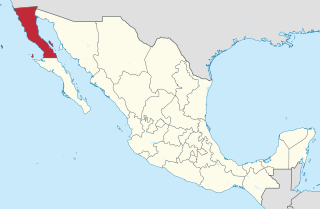
Mexico City is the capital and largest city of Mexico, and the most populous city in North America. It is one of the country's 32 federal entities. Mexico City is one of the most important cultural and financial centers in the world. It is located in the Valley of Mexico in the high central plateau, at an altitude of 2,240 meters (7,350 ft). The city has 16 boroughs or demarcaciones territoriales, which are in turn divided into neighborhoods or colonias.

North America is a continent in the Northern Hemisphere and almost entirely within the Western Hemisphere. It is bordered to the north by the Arctic Ocean, to the east by the Atlantic Ocean, to the southeast by South America and the Caribbean Sea, and to the west and south by the Pacific Ocean. Because it is on the North American Tectonic Plate, Greenland is included as a part of North America geographically.

New Mexico is a state in the Southwestern United States. It is one of the Mountain States of the southern Rocky Mountains, sharing the Four Corners region of the western U.S. with Utah, Colorado, and Arizona, and bordering Texas to the east and southeast, Oklahoma to the northeast, and the Mexican states of Chihuahua and Sonora to the south. The state capital is Santa Fe, which is the oldest capital in the U.S., founded in 1610 as the government seat of Nuevo México in New Spain; the largest city is Albuquerque.

Albuquerque, abbreviated as ABQ, is the most populous city in the U.S. state of New Mexico. Its nicknames, The Duke City and Burque, both reference its 1706 founding by Nuevo México governor Francisco Cuervo y Valdés as La Villa de Alburquerque. Named in honor of the Viceroy of New Spain, the 10th Duke of Alburquerque, the city was an outpost on El Camino Real linking Mexico City to the northernmost territories of New Spain. The 2020 census found the population of the city to be 564,559, making Albuquerque the 32nd-most populous city in the United States and the fourth-largest in the Southwest. It is the principal city of the Albuquerque metropolitan area, which had 916,528 residents as of July 2020, and it is part of the Albuquerque–Santa Fe–Las Vegas combined statistical area which had a population of 1,162,523 as of January 2020. Located in the Albuquerque Basin, the city is flanked by the Sandia Mountains to the east and the West Mesa to the west, with the Rio Grande and bosque flowing from north-to-south. The city is a hub for technology and media companies, historic landmarks, University of New Mexico, Albuquerque International Balloon Fiesta, Gathering of Nations, New Mexico State Fair, also a diverse restaurant scene including New Mexican cuisine.

The Mexican Revolution was an extended sequence of armed regional conflicts in Mexico from approximately 1910 to 1920. It has been called "the defining event of modern Mexican history". It resulted in the destruction of the Federal Army and its replacement with a revolutionary army, as well as the transformation of Mexican culture and government. The northern Constitutionalist faction prevailed on the battlefield and drafted the present-day Constitution of Mexico, which aimed to create a strong central government, with revolutionary generals holding power from 1920 to 1940. The revolutionary conflict was primarily a civil war, but foreign powers, having important economic and strategic interests in Mexico, figured in the outcome of Mexico's power struggles. The United States played an especially significant role.

Billy the Kid, also known by the pseudonym William H. Bonney, was an outlaw and gunfighter of the American Old West, who killed eight men before he was shot and killed at the age of 21. He also fought in New Mexico's Lincoln County War, during which he allegedly committed three murders.

Magdalena Carmen Frida Kahlo y Calderón was a Mexican painter known for her many portraits, self-portraits, and works inspired by the nature and artifacts of Mexico. Inspired by the country's popular culture, she employed a naïve folk art style to explore questions of identity, postcolonialism, gender, class, and race in Mexican society. Her paintings often had strong autobiographical elements and mixed realism with fantasy. In addition to belonging to the post-revolutionary Mexicayotl movement, which sought to define a Mexican identity, Kahlo has been described as a surrealist or magical realist. She is known for painting about her experience of chronic pain.

Baja California, officially the Free and Sovereign State of Baja California is a state in Mexico. It is the northernmost and westernmost of the 32 federal entities of Mexico. Before becoming a state in 1952, the area was known as the North Territory of Baja California. It has an area of 70,113 km2 (27,071 sq mi) and comprises the northern half of the Baja California Peninsula, north of the 28th parallel, plus oceanic Guadalupe Island. The mainland portion of the state is bordered on the west by the Pacific Ocean; on the east by Sonora, the U.S. state of Arizona, and the Gulf of California; on the north by the U.S. state of California; and on the south by Baja California Sur.

The Battle of the Alamo was a pivotal event in the Texas Revolution. Following a 13-day siege, Mexican troops under President General Antonio López de Santa Anna reclaimed the Alamo Mission near San Antonio de Béxar, killing most of the Texians and Tejanos inside. Santa Anna's cruelty during the battle inspired many Texians and Tejanos to join the Texian Army. Buoyed by a desire for revenge, the Texians defeated the Mexican Army at the Battle of San Jacinto, on April 21, 1836, ending the rebellion in favor of the newly formed Republic of Texas.

Mexicans are the citizens of the United Mexican States.

The Mexico national football team represents Mexico in international football and is governed by the Mexican Football Federation. It competes as a member of CONCACAF.

Mexico, officially the United Mexican States, is a country in the southern portion of North America. It is bordered to the north by the United States; to the south and west by the Pacific Ocean; to the southeast by Guatemala, Belize, and the Caribbean Sea; and to the east by the Gulf of Mexico. Mexico covers 1,972,550 square kilometers (761,610 sq mi), making it the world's 13th-largest country by area; with approximately 126,014,024 inhabitants, it is the 10th-most-populous country and has the most Spanish-speakers. Mexico is organized as a federal republic comprising 31 states and Mexico City, its capital. Other major urban areas include Monterrey, Guadalajara, Puebla, Toluca, Tijuana, Ciudad Juárez, and León.

Joaquín Archivaldo Guzmán Loera, commonly known as "El Chapo" because of his 168 cm stature, is a Mexican former drug lord and a former leader within the Sinaloa Cartel, an international crime syndicate. He is considered to have been one of the most powerful drug traffickers in the world.

Rafael Caro Quintero is a Mexican drug lord who co-founded the now-disintegrated Guadalajara Cartel with Miguel Ángel Félix Gallardo and other drug traffickers in the late 1970s. He is the brother of fellow drug trafficker Miguel Caro Quintero, founder and former leader of the defunct Sonora Cartel.
The Mexican drug war is the Mexican theater of the global war on drugs, as led by the U.S. federal government, an ongoing asymmetric low-intensity conflict between the Mexican government and various drug trafficking syndicates. When the Mexican military began to intervene in 2006, the government's main objective was to reduce drug-related violence. The Mexican government has asserted that their primary focus is dismantling the cartels, and preventing drug trafficking demand along with U.S. functionaries.

The Sinaloa Cartel, also known as the CDS, the Guzmán-Loera Organization, the Pacific Cartel, the Federation and the Blood Alliance, is a large international drug trafficking, money laundering, and organized crime syndicate established in Mexico during the late 1980s as one of a various number of "plazas" operating under a predecessor organization known as the Guadalajara Cartel. It is currently headed by Ismael Zambada García and is based in the city of Culiacán, Sinaloa, with operations in many world regions but primarily in the Mexican states of Sinaloa, Baja California, Durango, Sonora, and Chihuahua. It also has a notable presence in a number of other regions in Latin America, such as Colombia; as well as in cities across the U.S. The United States Intelligence Community generally considers the Sinaloa Cartel to be the most powerful drug trafficking organization in the Western Hemisphere, making it perhaps even more influential and capable than the infamous Medellín Cartel of Colombia was during its prime. It has repeatedly been said to be one of the strongest criminal organizations in the world and indisputably the most powerful in Mexico since at least the late 2000s and early 2010s by various sources including the Los Angeles Times.

The Mexican–American War, also known in the United States as the Mexican War and in Mexico as the Intervención estadounidense en México, was an armed conflict between the United States and Mexico from 1846 to 1848. It followed the 1845 U.S. annexation of Texas, which Mexico considered Mexican territory because it did not recognize the Velasco treaty signed by Mexican General Antonio López de Santa Anna when he was a prisoner of the Texian Army during the 1836 Texas Revolution. The Republic of Texas was de facto an independent country, but most of its citizens wished to be annexed by the United States. Domestic sectional politics in the U.S. were preventing annexation since Texas would have been a slave state, upsetting the balance of power between Northern free states and Southern slave states. In the 1844 United States presidential election, Democrat James K. Polk was elected on a platform of expanding U.S. territory in Oregon and Texas. Polk advocated expansion by either peaceful means or armed force, with the 1845 annexation of Texas furthering that goal by peaceful means. However, the boundary between Texas and Mexico was disputed, with the Republic of Texas and the U.S. asserting it to be the Rio Grande and Mexico claiming it to be the more-northern Nueces River. Both Mexico and the U.S. claimed the disputed area and sent troops. Polk sent U.S. Army troops to the area; he also sent a diplomatic mission to Mexico to try to negotiate the sale of territory. Mexican forces attacked U.S. forces, and the United States Congress declared war.

The Gulf of Mexico is an ocean basin and a marginal sea of the Atlantic Ocean, largely surrounded by the North American continent. It is bounded on the northeast, north and northwest by the Gulf Coast of the United States; on the southwest and south by the Mexican states of Tamaulipas, Veracruz, Tabasco, Campeche, Yucatan, and Quintana Roo; and on the southeast by Cuba. The Southern U.S. states of Texas, Louisiana, Mississippi, Alabama, and Florida, which border the Gulf on the north, are often referred to as the "Third Coast" of the United States.

Enrique "Kiki" Camarena Salazar was an American intelligence officer for the United States Drug Enforcement Administration (DEA). In February 1985 Camarena was kidnapped by drug traffickers hired by Mexican politicians in Guadalajara, Mexico. He was interrogated under torture and murdered. Three leaders of the Guadalajara drug cartel were eventually convicted in Mexico for Camarena's murder. The U.S. investigation into Camarena's murder led to ten more trials in Los Angeles for other Mexican nationals involved in the crime. The case continues to trouble U.S.–Mexican relations, most recently when one of the three convicted traffickers, Rafael Caro Quintero, was released from a Mexican prison in 2013. Caro Quintero was again captured by Mexican Forces in July 2022.
















